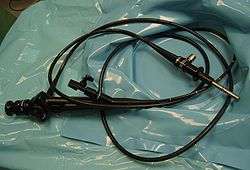Renal papillary necrosis
| Renal papillary necrosis | |
|---|---|
 | |
| Frontal section through the kidney | |
| Classification and external resources | |
| Specialty | urology, nephrology |
| ICD-10 | N17.2 |
| ICD-9-CM | 584.7 |
| DiseasesDB | 9572 |
| MedlinePlus | 000488 |
| eMedicine | med/2839 radio/523 |
| MeSH | D007681 |
Renal papillary necrosis is a form of nephropathy involving the necrosis of the renal papilla.[1] Lesions that characterize renal papillary necrosis come from an impairment of the blood supply and from subsequent ischemic necrosis that is diffuse.[2]
Signs and Symptoms
Symptoms (and signs) consistent with renal papillary necrosis are:[1]
- Back pain
- Cloudy urine
- Tissue pieces (in urine)
- Fever
- Painful/frequent urination
- Urinary incontinence
Causes
In terms of cause, almost any condition that involves ischemia can lead to renal papillary necrosis. A mnemonic for the causes of renal papillary necrosis is POSTCARDS: pyelonephritis, obstruction of the urogenital tract, sickle cell disease, tuberculosis, cirrhosis of the liver, analgesia/alcohol abuse, renal vein thrombosis, diabetes mellitus, and systemic vasculitis.[3] Often, a patient with renal papillary necrosis will have numerous conditions acting synergistically to bring about the disease.[4]
Analgesic nephropathy is a common cause of renal papillary necrosis. The damage is cumulative and most patients of renal papillary necrosis would have ingested at least 2 kg of analgesics in the past. The risk is higher for phenacetin (which was withdrawn from market in the United States) and paracetamol (acetaminophen) compared to aspirin and other NSAIDs.
Pathophysiology
The pathophysiology of this condition can be due to analgesic nephropathy, which in turn is a result of long-term use of aspirin.[5] It is a sequence of vascular occlusion, vasospasm, then infection and finally obstruction which leads to RPN.[6]
Diagnosis

Individuals with renal papillary necrosis due to excess use of analgesic have an elevated risk of epithelial tumors, hence a urine cytology exam is useful.[7] In terms of imaging this condition can be identified by retrograde pyelography (RGP).[8] The diagnosis of renal papillary necrosis is therefore done via:[9]
- Urinalysis
- Blood cell count
- Urine cytology study
- Imaging study (with intravenous contrast)
- Cystoscopy
- Ureteroscopy
Treatment
Treatment of renal papillary necrosis is supportive, any obstruction (urethral) can be dealt with via stenting. This condition is not linked to a higher possibility of renal failure.[10] Control of infection is important, thus antimicrobial treatment is begun, so as to avert surgery (should the infection not respond).[11]
References
- 1 2 "Renal Papillary Necrosis". Medline. NIH. Retrieved 15 October 2015.
- ↑ Jung, Dae Chul; Kim, Seung Hyup; Jung, Sung Il; Hwang, Sung Il; Kim, Sun Ho (November 2006). "Renal Papillary Necrosis: Review and Comparison of Findings at Multi–Detector Row CT and Intravenous Urography1". RadioGraphics. 26 (6): 1827–1836. doi:10.1148/rg.266065039. PMID 17102053. Retrieved 15 October 2015.
- ↑ Kim, Seung Hyup (2011-11-19). Radiology Illustrated: Uroradiology. Springer Science & Business Media. p. 471. ISBN 9783642053221.
- ↑ Powell, Christopher. "Papillary Necrosis". Medscape Reference. Retrieved 10 Nov 2011.
- ↑ "Analgesic Nephropathy. Chronic kidney disease information. Patient | Patient". Patient. Retrieved 2015-10-15.
- ↑ Greenberg, Arthur; Cheung, Alfred K. (2005-01-01). Primer on Kidney Diseases. Elsevier Health Sciences. p. 387. ISBN 1416023127.
- ↑ Wein, Alan J.; Kavoussi, Louis R.; Novick, Andrew C.; Partin, Alan W.; Peters, Craig A. (2011-09-28). Campbell-Walsh Urology. Elsevier Health Sciences. p. 269. ISBN 1455722987.
- ↑ Kim, Seung Hyup (2011-11-19). Radiology Illustrated: Uroradiology. Springer Science & Business Media. p. 472. ISBN 9783642053221.
- ↑ "Papillary Necrosis Workup: Laboratory Studies, Imaging Studies, Diagnostic Procedures". emedicine.medscape.com. Retrieved 2015-10-15.
- ↑ Schrier, Robert W. (2007-01-01). Diseases of the Kidney and Urinary Tract. Lippincott Williams & Wilkins. p. 2008. ISBN 9780781793070.
- ↑ Schlossberg, David (2015-04-23). Clinical Infectious Disease. Cambridge University Press. p. 438. ISBN 9781107038912.
Further reading
- Steinberg, Martin H.; Forget, Bernard G.; Higgs, Douglas R. (2009-08-17). Disorders of Hemoglobin: Genetics, Pathophysiology, and Clinical Management. Cambridge University Press. ISBN 9780521875196.
- Stern, Adam W.; Ritchey, Jerry W.; Hall, Brittany; Ketz-Riley, Cornelia J.; Genova, Suzanne G. (2010-05-01). "Nonsteroidal Anti-Inflammatory Drug—Associated Renal Papillary Necrosis in a White-Tailed Deer (Odocoileus Virginianus)". Journal of Veterinary Diagnostic Investigation. 22 (3): 476–478. doi:10.1177/104063871002200328. ISSN 1040-6387. PMID 20453233.